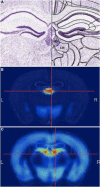The medial habenula: still neglected
- PMID: 24478666
- PMCID: PMC3894476
- DOI: 10.3389/fnhum.2013.00931
The medial habenula: still neglected
Abstract
The habenula is a small, bilateral brain structure located at the dorsal end of the diencephalon. This structure sends projections to the dopaminergic striatum and receives inputs from the limbic forebrain, making the habenula a unique modulator of cross-talk between these brain regions. Despite strong interest in the habenula during the seventies and eighties (Herkenham and Nauta, 1977; Beckstead, 1979; Beckstead et al., 1979; Herkenham and Nauta, 1979; Caldecott-Hazard et al., 1988), interest waned due to lack of a clearly identifiable functional role. Following Matsumoto and Hikosaka's seminal work on the lateral habenula as a predictor of negative reward in monkeys, the habenula has undergone a resurgence of scientific interest. Matsumoto and Hikosaka demonstrated an increase in habenular neuron firing when monkeys did not receive an expected juice reward (Matsumoto and Hikosaka, 2007). Studies have shown that increased habenular activity inactivates dopaminergic cells in the Rostromedial Tegmental Nucleus (RMTg) through GABAergic mechanisms (Jhou et al., 2009a,b). Additional studies link habenular activity to the regulation of serotonin and norepinephrine, suggesting the habenula modulates multiple brain systems (Strecker and Rosengren, 1989; Amat et al., 2001). These discoveries ushered in a series of new studies that have refocused attention on the lateral habenula and the importance of this small brain structure (Bianco and Wilson, 2009; Jhou et al., 2009a; Matsumoto and Hikosaka, 2009; Sartorius et al., 2010; Savitz et al., 2011). Recently, Geisler and Trimble reviewed this renewed interest in: The Lateral Habenula: No Longer Neglected (Geisler and Trimble, 2008). While the lateral habenula (LHb) has been extensively studied, the anatomically and histochemically distinct medial habenula (MHb) remains largely understudied. This short review argues that the MHb is functionally important and should be studied more aggressively.
Keywords: addiction; medial habenula (MHb); nicotinic receptors; stria medullaris; tobacco.
Figures

References
-
- Amat J., Sparks P., Matus-Amat P., Griggs J., Watkins L., Maier S. (2001). The role of the habenular complex in the elevation of dorsal raphe nucleus serotonin and the changes in the behavioral responses produced by uncontrollable stress. Brain Res. 917, 118–126 10.1016/S0006-8993(01)02934-1 - DOI - PubMed
-
- Balcita-Pedicino J. J., Omelchenko N., Bell R., Sesack S. R. (2011). The inhibitory influence of the lateral habenula on midbrain dopamine cells: ultrastructural evidence for indirect mediation via the rostromedial mesopontine tegmental nucleus. J. Comp. Neurol. 519, 1143–1164 10.1002/cne.22561 - DOI - PMC - PubMed
Publication types
Grants and funding
LinkOut - more resources
Full Text Sources
Other Literature Sources

